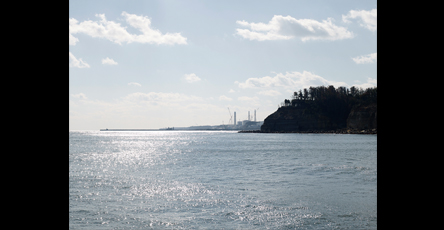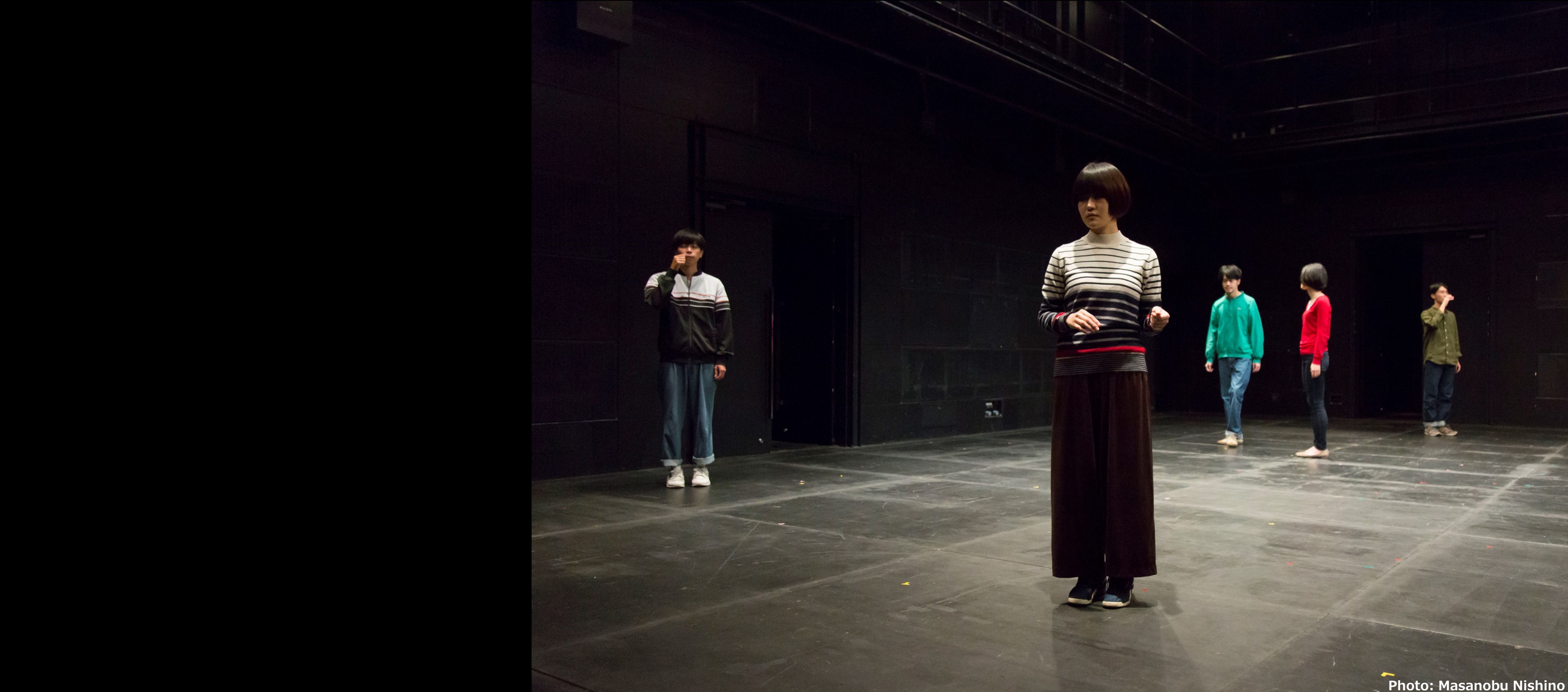
marebito theater company
“Performing Fukushima” Archive
Introduction
- Marebito theater company’s “Performing Fukushima” was staged at Festival/Tokyo for three consecutive years from 2016. An extension of the earlier “Performing Nagasaki” (2013–16), it deals with the theme of an irradiated city. Like its predecessor, the project staged short plays written by a team of playwrights based on their experiences doing research on-site. Each performance featured a different set of plays; the same play was never performed twice. The 67 plays by the five writers in 2016 and eight in both 2017 and 2018 were staged over a total 20 performances. We would now like to look back on “Performing Fukushima” and explore what kind of project it was.
marebito theater company
- The three years of marebito theater company’s “Performing Fukushima” (and six if one includes the preceding “Performing Nagasaki”) were a series of quiet surprises. Though there were as many as 67 plays written by a team of dramatists after visiting the area, all of the plays were performed only once. This is because actual incidents also occur only once. Furthermore, these plays were performed on an almost completely bare theatre stage, using just the bodies of the actors while wearing their ordinary clothes. As a result of these efforts, what emerged was something akin to a transparent city created only out of “incidents.” This is theatre that makes the “empty space” necessary again and attempts, through the most minimum of gestures, to convey what perhaps happened faraway (and what may perhaps happen to anyone). It is my hope that this archive helps to open up the performances, which are fundamentally things that do not remain after they are over, to later encounters.
Kaku Nagashima (Director, F/T)
F/T16 “Performing Fukushima” Photo: Masanobu Nishino
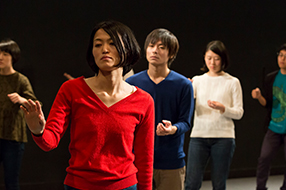 F/T17 “Performing Fukushima” Photo: Masanobu Nishino
F/T17 “Performing Fukushima” Photo: Masanobu Nishino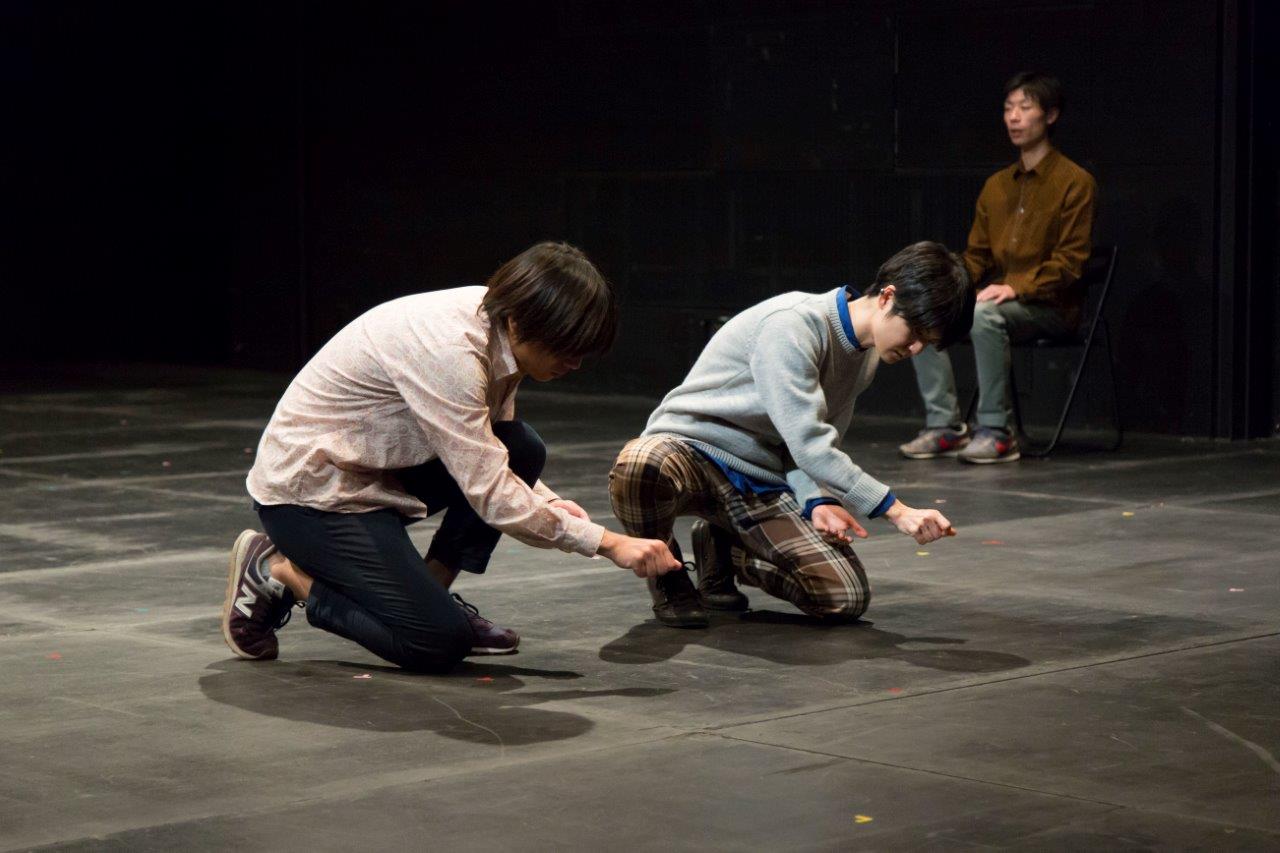 F/T18 “Performing Fukushima” Photo: Masanobu Nishino
F/T18 “Performing Fukushima” Photo: Masanobu Nishino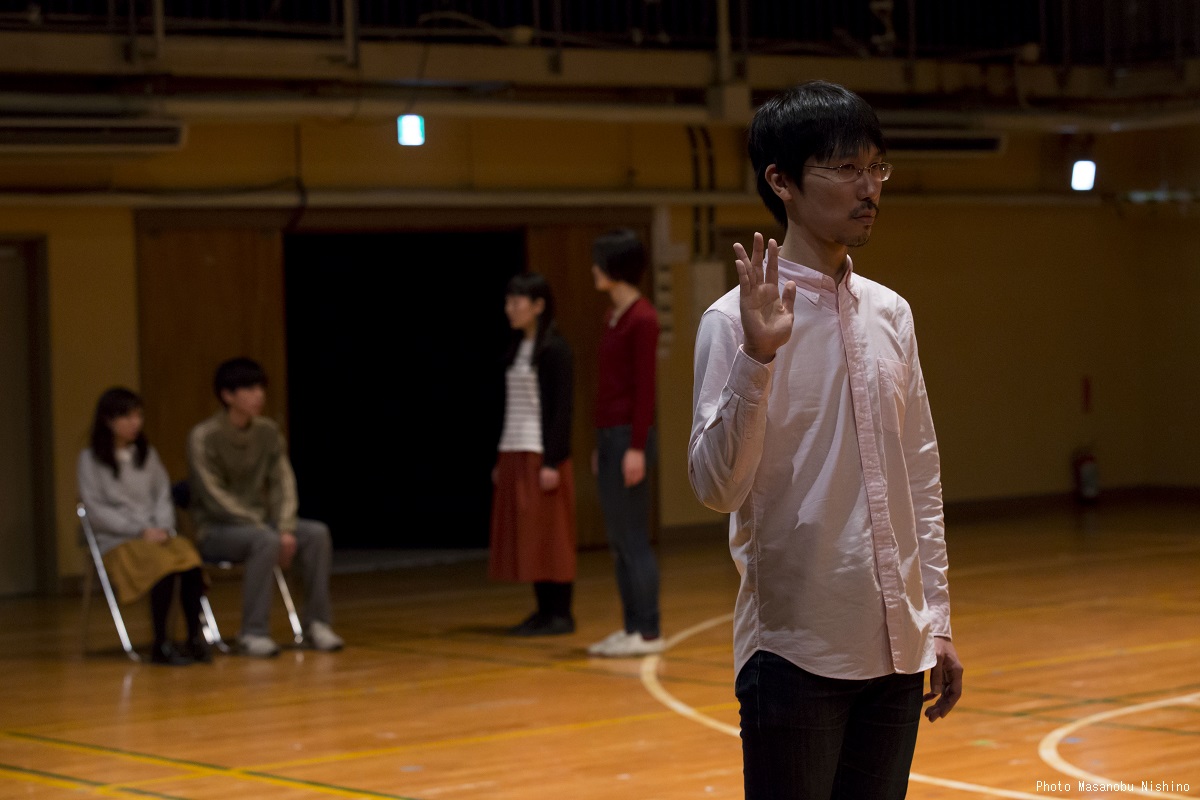 F/T16 “Performing Fukushima” Photo: Masanobu Nishino
F/T16 “Performing Fukushima” Photo: Masanobu Nishino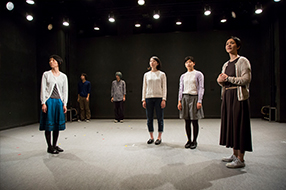 F/T17 “Performing Fukushima” Photo: Masanobu Nishino
F/T17 “Performing Fukushima” Photo: Masanobu Nishino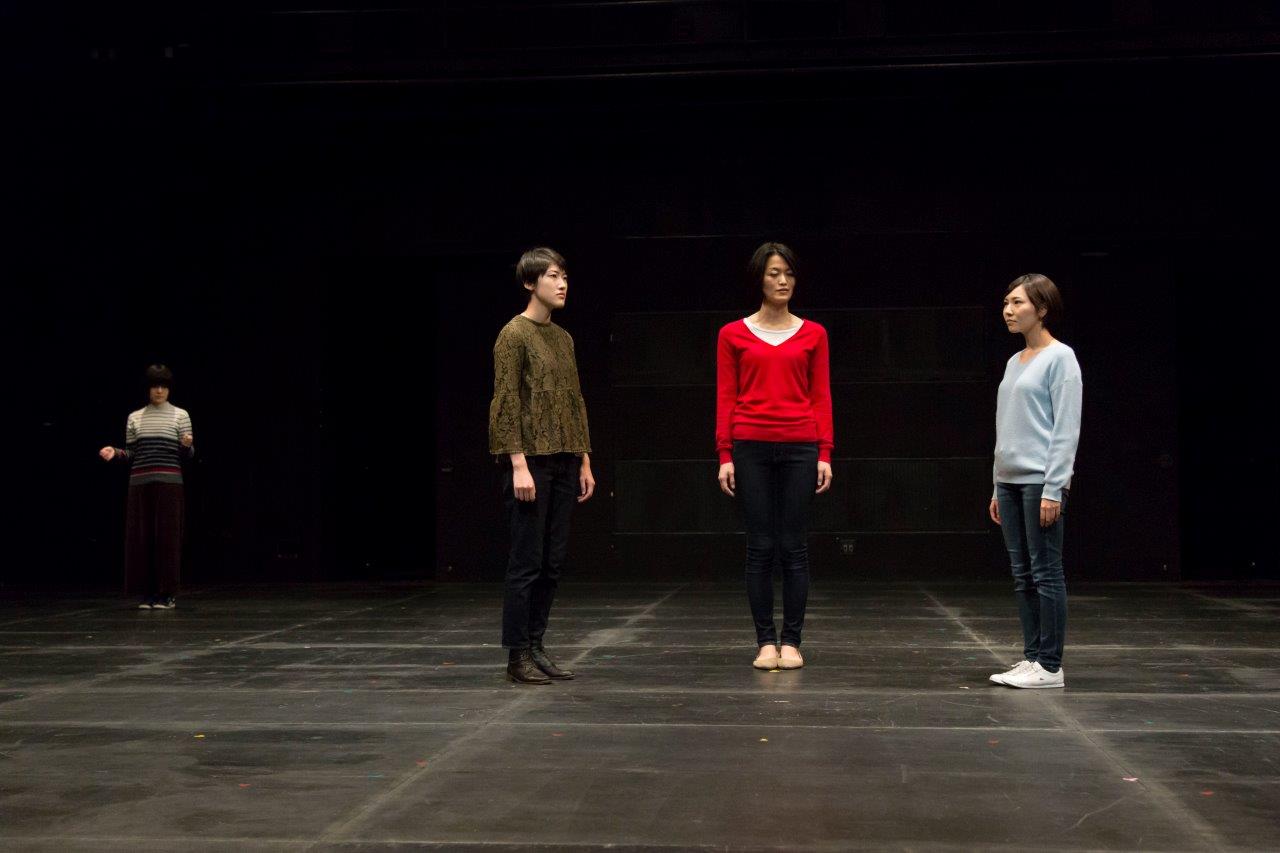 F/T18 “Performing Fukushima” Photo: Masanobu Nishino
F/T18 “Performing Fukushima” Photo: Masanobu Nishino
Videos (from F/T18 “Performing Fukushima”)
-
10/25 19:30
Father’s Death and Yonomori (Masataka Matsuda) -
10/25 19:30
Where Things Drift Ashore (Tomoyuki Takahashi)
Man Without Coordinates (Mitsuru Aida)
The man who wants to put up an advertisement (Keisuke Kamiya) -
10/26 19:30
The Grass Carp and the Turtle (Takashi Shima)
Home on the Range (Natsuka Kusano) -
10/26 19:30
The Miren Waterfall (Mitsuru Aida)
Ammonite Center (Keisuke Kamiya) -
10/27 18:00
Art School (Keisuke Kamiya)
Fukushima Seashore (Ippei Miyake) -
10/27 18:00
Citizens of Koriyama (Saki Yamada)
A Typical Sunday (Natsuka Kusano) -
10/28 14:00
About to Snow (Takashi Shima)
The Month Without Water (June) (Ippei Miyake) -
10/28 14:00
From the Periphery of Standard Time (Tomoyuki Takahashi)
At Iwaki General Library (Masataka Matsuda)
Overview
We would like to provide an overview of marebito theater company’s “Performing Fukushima” through the following three topics: firstly, the format of the performance; secondly, the creative process; and thirdly, the changes over the three years of the project.
(1) Performance Format
On stage is nothing other than chairs and boxes; it is essentially a bare stage. Not only is there no set, the actors do not use props but rather employ mime as necessary. While each performance features different plays, the actors’ costumes fundamentally do not alter. In terms of the lighting, though a certain level of brightness is maintained, there is no conspicuous change during the performance. No added sounds are used.
The acting fundamentally consists of speaking the dialogue and performing the gestures and actions as written in the script; importance is not attached to performing in ways that deviate from the script. In the speech of the actors, there is no particularly deliberate attempt at intonation, meaning that when the dialogue is spoken quietly it may not be audible to the audience. There may be times, for instance, when speech overlaps, such as in a conversation in a cafe. The overlapping nature of the dialogue may mean the individual voices cannot be distinguished, with the voices speaking over the top of each other and resulting in noise rather than clearly delivered lines of dialogue.
(2) Creative Process
The scripts are written by a team of playwrights (in the case of “Performing Fukushima,” a total eight writers). Each playwright must travel to the research site of “Fukushima” in order to write his or her contribution. However, while this process is called “research,” the only condition is that they “go” to Fukushima and there are no other special stipulations. A writer may make what he or she encountered by chance into the subject of the play. In this way, research is undertaken sporadically by the writers, depicting the incidents that take place in Fukushima. Moreover, the Fukushima setting is hard to identify in certain plays.
After the plays are written begins the work of converting what is “invisible” (that is, the play script) into what is “visible” (that is, the staging). Through the scripts of the writers, the actors express the “Fukushima” that the writers found during their research. Though some writers also may serve as actors, the actors perform multiple roles straddling multiple plays, meaning actors inevitably appear in plays that they did not write themselves. Moreover, when considering not only the relationship between the writer and the actor but also that between the performance and the audience, the latter comes to perceive “Fukushima” through the performance by the actors.
(3) Changes over the Three Years
The aforementioned two aspects have not fundamentally changed since the predecessor project, “Performing Nagasaki.” However, “Performing Fukushima” has changed gradually in certain other ways over the three years of its development.
The most significant change is the theatre venue. The first year’s version was staged in the Nishi-Sugamo Arts Factory, a renovated school gymnasium. The second year took place in Theater Green, a long-running small theatre venue in Ikebukuro. The third year was at a so-called black box theatre space inside Tokyo Metropolitan Theatre, one of Tokyo’s most representative public theatre venues.
The locations of the research have also changed over the three years. The first year’s research took place entirely within Fukushima City, while the second included areas in the prefecture formerly within the exclusion zone and where the evacuation order had been subsequently lifted. The third year stipulated that the writers had to visit places in the Hamadori region in the east of the prefecture. In this way, the research sites have gradually moved toward the sea. For the third year, the writers also met in advance to check the locations where they would go as well as discuss the number of plays and standard performance running time.
That concludes our explanation of “Performing Fukushima” through those three topics. As such, how were the issues of the nuclear accident in Fukushima and its accompanying problem of radiation positioned within the performances? When the disaster and incident occurred, the words and footage that related these problems tended to portray a narrative that was easy to understand. On the other hand, “Performing Fukushima” aimed to create theatre that did not fall back on interchangeable or reproducible representation. What marebito theater company has attempted to do is make theatre that simultaneously initiates the time of the play scripts and the time of the theatre space—that is, the time of fiction alongside the time of the reality in front of you. More concretely, the present body of the irreplaceable actor appears while employing the completely variable means of mime. The format whereby each performance is a staging of different plays also works to emphasize the one-time nature of theatre.
In general, the Fukushima nuclear accident is treated as a universal incident for the whole of mankind to remember. On the other hand, there are seemingly contrasting incidents that are specific and individual, yet forgotten within our everyday lives. But are these two types of incidents—the universal incident and the individual and specific incident—really antithetical? Is the problem of radiation actually rather concealed within our daily lives? “Performing Fukushima” is both a performance-incident that cannot be grasped as either universal or specific, as well as an inquiry not anchored in a time or place.
marebito theater company
2016 Plays
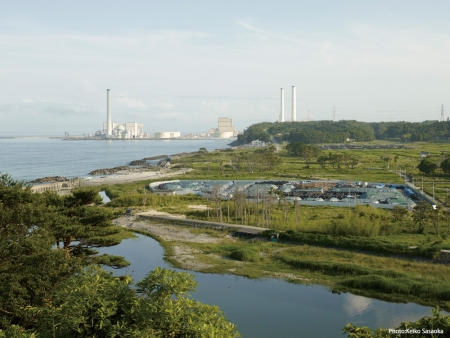
11/17
Fukushima City Hall (Saki Yamada)
Mosquitos (Ippei Miyake)
Throw a Song, Like a Ball (Mitsuru Aida)
A Stranger (Masataka Matsuda)
Tobu Gymnasium (Saki Yamada)
11/18
The Boy and the Driver (Ippei Miyake)
Senganmori (Keisuke Kamiya)
Laughter (Masataka Matsuda)
Mosquitos (Ippei Miyake)
Steam, Roadside (Mitsuru Aida)
11/19
Like a Woman (Masataka Matsuda)
The Police Station Dojo (Keisuke Kamiya)
Mosquitos (Ippei Miyake)
Dream Junky (Mitsuru Aida)
Dancing at Machinaka Hiroba (Masataka Matsuda)
11/20
Fukushima District Court (Saki Yamada)
The Man From Kobe (Ippei Miyake)
Greeting (Mitsuru Aida)
Mosquitos (Ippei Miyake)
At Starbucks (Masataka Matsuda)
The Patio (Ippei Miyake)

Fukushima City Hall
→Script (PDF)Visiting Fukushima for research but caught by record-breaking rainfall, I had no choice but to look around facilities near my accommodation. I first went to Fukushima City Hall, a walk of just two minutes but one that still left me completely drenched. The play became a story about wandering around the city hall building, including two businessmen from a photocopier manufacturer I met that night at a restaurant. I was inspired to write a play about what happens while moving inside a building and where the story is told in a very disparate way. (Saki Yamada)
Mosquitos
→Script (PDF)This play comprises four little pieces, each of which is a simple conversation or a short exchange of behavior. One is about people on their guard against mosquitos, only for a wasp to come and the people run away. Another is about a married couple passing by a man, and a mosquito almost simultaneously bites the husband and the man. Yet another is about two male junior high school students who are tickling each other until a mosquito lands on one of their faces. The final story is about a woman unable to sleep because of a mosquito and a man who is fast asleep. They are banal episodes about mosquitos that could take place seemingly anywhere. (Ippei Miyake)
Throw a Song, Like a Ball
→Script (PDF)Moving from Toyoharu Junior High School in Saitama, renowned for its student choir, to Fukushima, Yutaka Kawakami falls in love with a doctor called Hosaka. Having left his elite school and unable to bare his passion for singing, yet ignored by Hosaka, Yutaka spends his days moping around the throat clinic where Hosaka works, his depression unchecked or affected by the love clumsily shown by his mother Mariko or brother-in-law Tadashi. After suddenly and somewhat obstinately singing together at school with Yuki Okamoto, a fellow student who is concerned for him, Yutaka promises her he will attend choir practice the next day, having previously tended to bunk off. (Mitsuru Aida)
A Stranger
→Script (PDF)A mother and her daughter live in Fukushima City. The mother is tidying away in the kitchen after the evening meal. The daughter is watching TV. She eventually turns off the TV and goes to start her homework, but then becomes aware of the presence of a male stranger beside her. The mother and daughter are both surprised but, realizing the man is hungry, the mother makes him a rice ball, which he eats with relish and then leaves. What was this stranger’s visit? The mother sees the face of her dead husband, while the daughter ponders what it means for people to seem similar to someone. (Masataka Matsuda)
Tobu Gymnasium
→Script (PDF)Hearing that the venue for “Performing Fukushima” was a gymnasium, I was prompted to write this play about a sports club that I glimpsed through the large window of a gymnasium one evening after the rain. The two-story building was like a public hall and all that could be seen from the street outside was a ball and the backs of the people inside. (Saki Yamada)
The Boy and the Driver
→Script (PDF)A young boy has fled from a hospital. Using a wheelchair, he clenches some coins left in a vending machine and arrives at the taxi rank in front of the hospital. He knocks on the window of a taxi and surprises the driver. The driver then understands from the boy’s faltering speech that he has a strong wish to go to a river. Along the way, the driver treats the boy to an ice cream and they get to know each other better. Arriving at Abukuma River, the driver asks the boy if he would like to go into the water. Although initially hesitant, the boy lets the driver hold him and they wade into the shallows. Partway through the story there is a scene where the boy asks the robot Pepper how to get to the river. The play experiments with having a human being play a robot. (Ippei Miyake)
Senganmori
→Script (PDF)When first traveling to Fukushima City, I searched for places where I could somehow meet locals and he came across the Fukushima Iino UFO Museum. It features displays of photographs and accounts of UFO sightings near the mountain of Senganmori as well as various other UFO-related materials from around the world. It is not clear why UFOs would apparently appear like this in the area. The play depicts people drawn together at the museum by a strange magnetism. (Keisuke Kamiya)
Laughter
→Script (PDF)In Fukushima City, there is a cheap lodging that was formerly a long-established inn before the 2011 disaster. The protagonist, Satoru Tamura, is talking about laughter with his wife Ryoko and daughter Satsuki. Satsuki is Ryoko’s child from another relationship and not Satoru’s biological daughter. Satoru has recently let Ryoko handle the management of the lodging so that he can concentrate on writing poetry that he publishes on his blog. The three are now listening to a recording Satoru made of Satsuki and her friend reading the poetry and laughing. A decontamination worker, Shimizu, is staying at the lodging. Ryoko earns money by having sexual relations with the workers who stay and Shimizu is one such person. Satoru spends each evening drinking with his young male neighbors and living with abandon. That night he goes dead drunk to Shinobu Bridge and watches the Shinkansen bullet train pass by on its way to Tokyo. (Masataka Matsuda)
Steam, Roadside
→Script (PDF)Fukushima City resident Yokooka accompanies Kinuta, who has come from Kanagawa on a trip, and together they are walking to the Iizaka hot spring resort. Yokooka listens to Kinuta as she talks about her life so far while gazing at the rows of houses. They find a footbath and watch the water that is too hot to enter. A candid girl and children from the neighborhood surround Yokooka, but then leave, and the couple go their separate ways. On his way home, Yokooka takes turns washing his back with some elderly men at a public bath. Touched by human life, Yokooka phones his girlfriend, Kanako, but his proposal goes badly so he contacts another female friend. (Mitsuru Aida)
Just Like a Woman
→Script (PDF)Yukio Hirayama, who belongs to a comedy group, meets Maria Kawasaki, who is a member of a small political organization called the Small Women’s Party. The catalyst for their first meeting was when Kawasaki overheard the rehearsals for Hirayama’s group’s comedy show. The Small Women’s Party organizes its activities according to the ideas of Miyako Okaboshi, the party leader who wants to reform Japan’s male society through the small efforts of women. Hirayama is infatuated with Kawasaki but then one day finds out that she is in love with another party member, a woman called Ogawa. Hirayama tells Kawasaki that he will take it upon himself to tell Ogawa about how Kawasaki feels about her and to help ensure her love is requited. Kawasaki rejects his offer. Just at that moment, violence breaks out within the comedy group and the play ends with Hirayama about to become a victim of this. (Masataka Matsuda)
The Police Station Dojo
→Script (PDF)This play is deeply ingrained with the marebito theater company performance style whereby the audience gradually imagines a scene from the utterances and actions of the actors on a bare stage. Ir had long felt attracted to the visually curious way that police in Japan display seized stolen goods to the press by arranging them over a blue tarpaulin sheet. I was also interested in the spirit of martial arts that prizes gratitude toward the sacred space that is the dojo. The resulting play explores the theme of a situation that, while difficult to understand for outsiders, has become utterly normal for the people involved. (Keisuke Kamiya)
Dream Junky
→Script (PDF)Nayo has a dream about miso soup with a caterpillar in it. Megane hates listening to people talking about their dreams. Knowing this full well, Nayo takes delight in talking about his dreams in the university seminar room, unfazed when he makes Megane angry as always. Megane is furious at what Nayo says: “I want to tell you about my dream because you hate it.” Nato corrects himself, telling him he likes how he doesn’t enjoy stories about dreams. Before they know it, they are debating the structure of the dream. Nayo concludes by saying that eating a caterpillar was the key to seeing what lies beyond the dream, but Megane is left bewildered. (Mitsuru Aida)
Dancing at Machinaka Hiroba
→Script (PDF)In this loosely staged play, eleven people perform a group dance under the supervision of an instructor at Machinaka Hiroba, a plaza in the center of Fukushima City. (Masataka Matsuda)
Fukushima District Court
→Script (PDF)Caught by heavy rain, this was the second location that I could visit. Having nothing else to do, I sat in on three trial hearings. One was for a person who became a drug addict after their family left the area following the 2011 disaster, while another trial involved a tearful family dealing with a 15-year sentence handed down to the defendant. However, I ultimately wrote about a habitual fare dodger, a case that on the surface seemed the least exciting as a story. The play was inspired by the desire to create a kind of space from the defendant’s apathy toward his surroundings, his meticulous tricks refined from the previous times he was caught, and the strange camaraderie between the railway company employees with stable salaries deriding the defendant, who is someone too poor to buy tickets, during a break in the trial proceedings. (Saki Yamada)
The Man from Kobe
→Script (PDF)Sekiguchi, who came to Fukushima from Kobe to work in the post-disaster reconstruction, hits a child with his car. The child’s parents are divorced and seem to remain on bad terms. The monk who arrives for the funeral is more worldly than spiritual, and makes many indiscreet remarks. In despair, the mother is unsure how to respond to what he says. Sekiguchi, meanwhile, has become a drunk following the accident. Around this time, antipathy has spread locally toward the people who came from Osaka to Fukushima for the work. Detecting his Kansai region accent, Sekiguchi is turned away from a drinking establishment. He is picked up by a tout and taken to a hostess club. The drunk Sekiguchi becomes violent and flees the bar. During the research, I frequently heard hostile remarks about “Osaka people.” The play explores the way people tend to resort to discrimination during times of uncertainty. (Ippei Miyake)
Greeting
→Script (PDF)A girl arrives at the room of a boy. She says she has come to say hello, but the boy questions the original meaning of a greeting. The girl cannot answer. He explains that the word for “greeting” in Japanese derives from a dialogic Buddhist practice and that it means to check their answer and see if someone was properly trained as a Buddhist or, on the other hand, to probe or search for something. As such, he tacitly suggests that there is an ulterior motive to the girl’s visit. The girl becomes curious about the messy state of the boy’s room and, as if dancing, starts looking around the room. (Mitsuru Aida)
At Starbucks
→Script (PDF)The play is set in a branch of Starbucks inside JR Fukushima Station. An old married couple, female high school students, company employees, and various others are talking among themselves. A man appears. He is writing a play that he wants to stage in Tokyo. For this reason, he walked around Fukushima all of yesterday doing research. An apparent angel then appears and asks the writer if he can sit in the same seat. Receiving this request, the man tells the angel about the scene he saw while doing his research. Near an unmanned train station, he came upon a place enveloped in light. And as he tells the story, the man himself enters this scene. (Masataka Matsuda)
The Patrio
→Script (PDF)There is an apartment building with a patio-style inner courtyard. Separated by this courtyard, two sisters live in separate apartments. At the older sister Sumiko’s home, her daughter Momo is having a party with her friends from her time studying abroad. The party is noisy and can be heard outside. However, the midsummer patio remains tranquil. The two sisters are having a conversation across the courtyard, grumbling about housework or telling a kind of scary story. People are heading home from a nearby movie theater. They include a man and a woman who are on a date but not yet lovers, resulting in a rather awkward atmosphere between them. Eventually, the faint sounds of a saxophone are heard on the patio. It is apparently being played by the husband of someone who recently moved to the building from Chiba. His wife, however, is worried about the radiation from the nuclear power plant and is suffering from a mental illness. The two sisters then talk about their memories of the little trip they took one summer when they were young with their grandmother. Sumiko’s memories are unclear but the younger sister, Yoko, who back then already had a strong personality, continues talking about that time. Yoko went off by herself, leaving her grandmother and Sumiko and waiting a long time at the rural station for a train to come. I made a lot of effort to portray summer memories. (Ippei Miyake)
2017 Plays
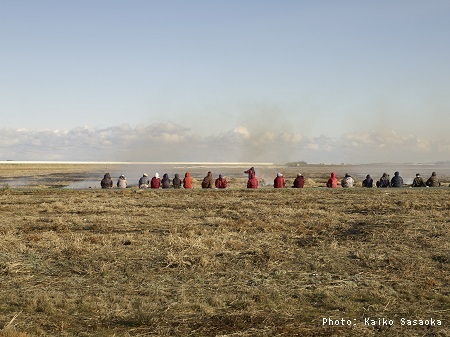
10/7 16:00
National Treasure Shiramizu Amida-do Temple (Saki Yamada)
Racetrack (Natsuka Kusano)
10/7 19:30
At the Meet-and-Greet Fan Event (Takashi Shima)
Iwaki City Coal & Fossil Museum (Horuru) (Masataka Matsuda)
The Old Man’s Story (Ippei Miyake)
10/8 14:00
Secret Hotel (Mitsuru Aida)
National Route 6 (Natsuka Kusano)
10/8 17:30
Every Day, Every Night (Masataka Matsuda)
Collecting the Remains (Ippei Miyake)
10/9 14:00
Satellite, Boat Pier, New Track (Tomoyuki Takahashi)
Conveyor Belt Sushi (Keisuke Kamiya)
Kozue and Mokichi (Ippei Miyake)
10/9 17:30
Tommy’s Barbershop (Mitsuru Aida)
The Tree of Tears (Ippei Miyake)
Aquamarine Fukushima: Coral Reef Sea (Masataka Matsuda)
The Sports Shop (Keisuke Kamiya)
10/12 19:30
Performance and Conspiracy (Masataka Matsuda)
Revolution (Keisuke Kamiya)
10/13 19:30
You Are My Theatre (Masataka Matsuda)
From Koyasu Bridge, Tomioka River (Takashi Shima)
10/14 16:00
A Bench at Aeon Cinema (Masataka Matsuda)
Metasuta (Mitsuru Aida)
10/14 19:30
2n People Who Cannot Go Home (Tomoyuki Takahashi)
Ban’etsu East Line to Iwaki (Masataka Matsuda)
10/15 14:00
Spinoff Edition: Fukushima, Osaka (Takashi Shima)
The Braille Library (Keisuke Kamiya)
Shioyazaki Lighthouse (Saki Yamada)
10/15 17:30
At the Former Site of a Bakery (Tomoyuki Takahashi)
The Suffering of Moriyama (Natsuka Kusano)
Her Highness Kazuko Kitashirakawa’s Visit to the Roadside Rest Area Yotsukura (Masataka Matsuda)

National Treasure Shiramizu Amida-do Temple
→Script (PDF)On her second trip to Fukushima, I rented a car. The play came from the my desire to write something in the first person about a place where she was aware that I looked like a tourist, even though there were almost no other visitors. (Saki Yamada)
Racetrack
→Script (PDF)Suguru and Yuki are a couple in their late twenties who go to the horse racetrack on a day off. Yuki is a novice when it comes to horse racing but sometimes wins on bets with high odds. Suguru is having an affair with a regular at a restaurant he goes to. Yuki is tired of her undefined relationship with Suguru. I wanted to write a play depicting a couple breaking up at a sunny horse racetrack where it feels like you are out for the day on a casual picnic. When I went to the racetrack in Fukushima, peaches were on sale right by the entrance. (Natsuka Kusano)
At the Meet-and-Greet Fan Event
→Script (PDF)At a live music venue in Iwaki, many ardent fans have gathered for an event celebrating the birthday of Shiori, a member of a local music idol group. Among the fans, however, is a man who looks suspiciously out of place. He has come in order to cause an incident, believing he can help Shiori quit the idol industry. The deified position of the “idol” does not leave them with any freedom. This is linked to the way people are fated to live in a certain place. The play is a story about Fukushima, where people are now forced to wear the “armor” of radiation. It asks us to consider how much soil will we have to dig up until we return to the previous Fukushima. (Takashi Shima)
Iwaki City Coal & Fossil Museum (Horuru)
→Script (PDF)The Iwaki City Coal & Fossil Museum (Horuru) is located in a suburb of Iwaki. The life of a coal-mining town in the early Showa period is recreated with to-scale models. Two women come to see the exhibits. They then go to a space where a futabasaurus dinosaur is on display. In the space, the history of the planet from its birth to the present is shown on a single line. Looking at this, the pair feels dizzy at just how tiny and insignificant their position within that history is and at the lack of coherence of the world that determined this. (Masataka Matsuda)
The Old Man’s Story
→Script (PDF)There was a man without much time left to live. This play is based on a conversation I had with that man. I think the man said that even after being told he does not have long to live, he wouldn’t give up on life. He spoke about that incredibly human, rough sensation of wanting to cling on to life. But for someone whose memory is fading as a side effect of his medication and can no longer remember what time it is, what is his concept of time now? This was the question that inspired the play. The person talking to the old man in the play is a stand-in for me, who slightly regrets the rather forced way I linked things to Fukushima. (Ippei Miyake)
Secret Hotel
→Script (PDF)In room 308 of the secret hotel, a female high school student is treated like a prostitute by her partner and becomes depressed. Miwa and Saori in room 310 are enjoying themselves in their room. Makita is in room 312 with his lover, Hideto. Waiting down on the street, Tatsuo starts a fight with Ikeda, who has just come out of room 311, but is scolded by his superior, Kaji. Having heard from Saori about a man, Miwa and Saori decide to bring their party to an end, while the schoolgirl bumps into Tatsuo on the street. Tatsuo having left with Kaji, the student is called over by Miwa after parting ways with Saori, but she doesn’t accompany Miwa and instead goes somewhere else. Miwa eventually sets off for home. (Mitsuru Aida)
National Route 6
→Script (PDF)Connecting inner Tokyo with Sendai, National Route 6 runs almost parallel with the JR Joban Line from a certain point in Ibaraki Prefecture onwards. I was driving in the Hamadori area of eastern Fukushima near the sea. Originally I wanted to write a drama that uses telephone communication. But when faced by the sight of large barricades like gates in front of the houses on either side of the road, of their gardens filled with vegetation that had grown far taller than a person, and by the abandoned convenience stores or pachinko parlors with their broken windows, I felt unable to put anything into words. I tried writing down all the types of vehicles that I saw and from there the play proceeded very smoothly. I particularly like how the weather forecasts for Fukushima featured in the play differ slightly across the prefecture’s three regions of Nakadori, Hamadori, and Aizu. (Natsuka Kusano)
Every Day, Every Night
→Script (PDF)One summer night at a house located some distance from Iwaki, the scriptwriter Sakura Ishimoto is working alone. The illustrator Mako Mori arrives. Sakura makes no attempt to conceal her surprise at Mako’s unexpected visit while she is trying to work. Mako has come to visit her old college friend Sakura because her job as an illustrator in Tokyo is not going well. Their lives together over the next few days involve various curious episodes. The neighbor Kaori Hijikata brings along her fiancé. Sakura lets two unemployed men she met at a local bar stay over. A strange-looking local pair of twins come and go. Mako sketches out these incidents over the days like a diary. (Masataka Matsuda)
Collecting the Remains
→Script (PDF)There are people who were hit by the tsunami and have still not been found. Their families and friends put on protective clothes and quietly head to the beach to search for any traces of them. It is a task that is carried out within a limited period of time. But it is not only happening in Fukushima; there are people all over the world looking for remains like this. In Chile, for instance, opponents of the former dictatorship were murdered and even their bodies disappeared. People continue now to search for pieces of bone among the sand. This is an impossible task of finding pulverized remains among the red soil. The play was inspired by the desire to portray the irreplaceability of someone that you love. (Ippei Miyake)
Satellite, Boat Pier, New Track
→Script (PDF)In the suburbs of Fukushima City, a building houses three legal betting shops. The ground floor is for betting on track cycling, the second floor for boat racing, and the third for horse racing. These are introduced in order during the course of the play. This is performed by the same actors playing three roles each. In all of the floors, the visitors exchange almost identically sounding conversations while continuing to place bets with similarly fixated gazes in the direction of the screens showing the respective sporting events. (Tomoyuki Takahashi)
Conveyor Belt Sushi
→Script (PDF)This play is about what happened later to two characters from “Art School.” A woman imagines what it is like to be the plates of sushi placed on the conveyor belt and travel around and around the restaurant. Next to her, a man eats sushi. (Keisuke Kamiya)
Kozue and Mokichi
→Script (PDF)The pregnant Kozue is knitting while waiting for her husband to come home. Her older brother, Mokichi, turns up for the first time in a while. Mokichi, who is always flitting from job to job, is relieved that Kozue’s child is doing fine. A heavy drinker, he actually came to Kozue’s home in order to get booze. He also tells her that he has quit his latest job and is again unemployed. He quit due to his coworker Kazu. The play ends with Mokichi hearing Kozue’s husband arriving home and hiding in order to jump out and surprise him. The short play depicts a small earthquake. It is the completely ordinary post-disaster landscape. (Ippei Miyake)
Tommy’s Barbershop
→Script (PDF)Ihara doesn’t take his temperature even if he gets a cold. This is because he doesn’t want to be misled by numbers. Tomii is shaving Ihara as he listens to this. The rather fastidious Fukunaga speaks with Aiba, who comes in later. For him, too, there are numbers that he doesn’t want to know about. Aiba asks Tomii why it is that a masseur will say “Good job” after giving someone a massage. Next in comes Sugita, who has many interests and whose grandchild is about to be born. Tomii asks Sugita about the “Good job” question. Sugita answers blandly that if something is needed to serve as a signal that something is over, then a gentle one works well. (Mitsuru Aida)
The Tree of Tears
→Script (PDF)Man 1 is hiding in a ditch, watching Man 2 and Man 3. Man 3 has come home. He presses the intercom but Man 2 is asleep and does not notice. Man 1 suddenly blows in his ear and Man 2 wakes up. Man 3 is a top civil servant who has been sent from Tokyo to Fukushima to help in the reconstruction. Fooling around with his boyfriend, Man 2, he grumbles about his job. Man 2 has left home but his father’s health has recently taken a turn for the worse. He is unsure about whether he should go home to see his father. To encourage Man 2, Man 3 tells him the story of the tree of tears. However, upon coming to the end of the story, Man 3 finds that Man 2 is fast asleep. Watching this, Man 1 lightly wipes away tears for some reason. (Ippei Miyake)
Aquamarine Fukushima: Coral Reef Sea
→Script (PDF)At the Aquamarine Fukushima aquarium, various people pass by the enormous Coral Reef Sea tank. (Masataka Matsuda)
The Sports Shop
→Script (PDF)I like the local sports shops that can be found in different areas. These sports shops sell the jerseys and indoor footwear designated by schools in the district. I remember the feeling in junior high school of inching closer to adulthood that came from wearing the school uniform or officially approved jersey. This is also the time when one’s relationship with others starts to become more complicated. Children form their own version of society among themselves. Even though we all experienced this ourselves once, after so much time we are no longer able to imagine how they feel. The resulting play explores the theme of using the imagination to compensate. (Keisuke Kamiya)
Performance and Conspiracy
→Script (PDF)At a university in the suburbs of Fukushima City, the members of a theatre club are rehearsing at an outdoor performance space. There have been staying on campus in order to concentrate on the rehearsals for their production of Sophocles’ “Oedipus at Colonus” to be performed in a few days’ time. However, the director Kitaura has gone missing and the performance is in crisis. The rehearsals have nonetheless continued, led by Takano, a senior member of the club who is playing the role of Oedipus in the production. The person playing the role of Ismene, Hino, hears from another member, Suzuki, that Kitaura’s disappearance is possibly a conspiracy by some unknown authority figures. Suzuki gives Hino a bottle with a letter that he says he picked up from the sea in Minamisoma, where Kitaura went missing. The letter was written by Kitaura and addressed to Hino. (Masataka Matsuda)
Revolution
→Script (PDF)The play is set not in Fukushima but in Havana, the capital city of Cuba. It was inspired by my experiences of staying in both Cuba and Fukushima. Cuba once wanted to build a nuclear power plant. Fully funded by the Soviet Union, the project was scrapped in 1992 just as it was nearing completion due to the collapse of the USSR. I had a sense that Cuba had taken a completely opposite direction to Japan’s. Though not an affluent nation by any means, it didn’t feel at all sad. It is a strangely optimistic and attractive country. The play is about a man who travels to Cuba from Fukushima and the woman he meets there. (Keisuke Kamiya)
You Are My Theatre
→Script (PDF)The play starts at the retirement party for Yamamura. Just as they are leaving the party and saying their goodbyes, they realize that among the small group a stranger has appeared without anyone noticing. They ask Yamamura who the person is. Yamamura replies that the person is “Theatre.” She explains that she used her retirement bonus to buy a theatre in human form. Yamamura then takes Theatre home, where she lives alone. Theatre starts to recite dialogue from Shakespeare’s “Romeo and Juliet” on Yamamura’s bed. Time passes and Yamamura takes Theatre on a walk along a path with a view of the Abukuma River. She makes Theatre perform the scene of Juliet’s suicide. Doing this, however, Theatre actually dies. (Masataka Matsuda)
From Koyasu Bridge, Tomioka River
→Script (PDF)In the town of Tomioka, Fukushima, two young sisters are wandering aimlessly. They say they are looking for their mother. Black bags of decontaminated waste are piled up high, but the girls do not know about radiation. This is because the characters in this play are actually animals left behind in Fukushima. The sisters meet Mr. Kami (literally, Mr. Paper), an old man who speaks in Osaka dialect. They ride on Mr. Kami’s back and fly up into the sky. This “paper” is the play script or text. The play was written as an attempt to probe the question of whether or not depicting bold and dynamic fiction on the page is important after the 2011 disaster. (Takashi Shima)
A Bench at Aeon Cinema
→Script (PDF)On the fifth floor of a shopping mall in Fukushima City, there is a bench by the entrance to Aeon Cinema. Various Fukushima locals come and go. Nonomiya and Mochizuki are sitting on the bench. They remember how they once happened to be on the same Ban’etsu East Line train bound for Iwaki and talk about that time. Mochizuki is a female college student attending a university in Fukushima and has just been to an orientation event about local corporations held on the fourth floor of the mall. Eventually, Sumire Miyaoka comes along to see Nonomiya. Miyaoka tells Nonomiya to stop following her around like a stalker. Mochizuki regrets sitting next to Nonomiya on the bench. (Masataka Matsuda)
Metasuta (Mitsuru Aida)
→Script (PDF)There is a shite (the main protagonist in a Noh play) and jiutai (chorus), performing the Noh play “Iwafune” (Sacred Stone Boat). A boy wants to buy a weekly manga magazine but he has no money. Mingling with the people looking around the grounds of Tsuruga Castle, he searches for any coins that may have been dropped. At the hill of Iimoriyama, a man and woman are on a date, but it’s not going well. The boy who wants to buy the magazines goes to Keiko, who works at a coffee shop called Kura, to sponge money, but instead just gets a free serving of pasta. The man at Iimoriyama visits a shrine and throws money into the offering box while thinking about the woman, only for the boy who wants to buy the magazine to catch the coin. This infuriates the man. The shite starts to dance. (Masataka Matsuda)
2n People Who Cannot Go Home
→Script (PDF)The high school student Maki Ando leaves her voluntary evacuation shelter in the Kanto region and goes to where her father, Satoshi, is living away from the family for work in Iwaki. Maki knows that her father is having an affair with Mirei, who was evacuated from the Fukushima exclusion zone to Iwaki. Every weekend in front of Iwaki Station, the high school student Yuki Izumida plays music on the street but is unsure about continuing after receiving an anonymous threat from someone. When Yuki performs, he looks just like Maki and the stories of these two people who have never met gradually converge. When originally performed, two different actors played Yuki for the scenes when he was not playing music and playing music, while the actor who played the latter also played the role of Maki. (Tomoyuki Takahashi)
Ban’etsu East Line to Iwaki
→Script (PDF)Various passengers are riding on a two-carriage train heading to Iwaki on the JR Ban’etsu East Line. Just as the train passes through the mountains, a foreign laborer says “Kamimata” and starts to look anxious. It seems like he is referring to a station called Kanmata. Another male passenger explains that the train has already passed that station and he should get off at the next stop and then take a train going back the other way. It is not clear if the foreign laborer fully understands but nonetheless he gets off at Kawamae Station. However, a piece of luggage is left behind and a married couple starts to speculate if it belongs to the foreign laborer who just got off. After coming to a stop, the train once again bustles with noise and commotion. (Masataka Matsuda)
Spinoff Edition: Fukushima, Osaka
→Script (PDF)In Osaka, there exists an area called Fukushima. There is also a town called Fukushima in Hiroshima Prefecture. In fact, there are many such “Fukushimas” around Japan. It is no exaggeration to say that these places were all contaminated by radiation after the 2011 disaster. This play is about a young boy searching for a girl based only on the information that she is waiting by a bridge in Fukushima. Meeting an unpopular YouTuber and a local old woman along the way, he eventually sets out for Osaka’s “Fukushima bridge,” which burned down in a great fire in the past. Looking back through history before the Great East Japan Earthquake, Japan has experienced many kinds of natural disasters across the ages. We must not allow the loss ushered in by such catastrophes to blight places just because they bear the name Fukushima. What is crucial to this play is the foolhardy choice of the young boy not to go to the eponymous prefecture in the Tohoku region of northeast Japan when he first hears the name “Fukushima.” (Takashi Shima)
The Braille Library
→Script (PDF)Braille libraries are facilities set up so that even the visually impaired can enjoy reading. There are now such facilities in every prefecture in Japan. At a Braille library, people make Braille books by converting preexisting publications into Braille as well as preparing audio books, which are recordings of a book read aloud. This play portrays the relationship at such a place between people who cannot read printed text. (Keisuke Kamiya)
Shioyazaki Lighthouse
→Script (PDF)This play that shifts vertically between different times and locations was inspired by my surprise at a particularly tall lighthouse as well as the incredible view of the coast from that lighthouse, one that felt almost like computer-generated imagery and gave no hint of what had happened there in the recent past. (Saki Yamada)
At the Former Site of a Bakery
→Script (PDF)At a residential neighborhood in the city of Minamisoma, tourists have followed a map to arrive at a bakery, only to discover that it is now an empty lot. Historic ruins were found while the shop was being renovated, with the result that it has transformed into an excavation site. The history of the location is told in fits and starts by the travelers who meet at the site as well as by the people doing the excavation work and the bakery owner, who comes every day to check on the excavation. Originally below sea level, the story of the place encompasses the activities of Neolithic people and its use during the Edo period as a paddock for horses, before reaching its recent history as an airfield for the army during the war. (Tomoyuki Takahashi)
The Suffering of Moriyama
→Script (PDF)This is a straight play about Nao Moriyama, who is waiting for someone at an outlet of a chain restaurant near Fukushima Station. A young man, Akira Toyama, arrives at the next table, where there is a mother and daughter. A regular at the bar the mother runs, Akira is apparently here to meet the daughter, Ayumi, and becoming her private tutor. Nao is killing time with a coloring book but finds herself unable to take her eyes away from the adjacent trio’s table and its uneasy mood. The basic scenario of the play, where a home tutor is introduced to a student, was something I actual witnessed at such a restaurant. (Natsuka Kusano)
Her Highness Kazuko Kitashirakawa’s Visit to the Roadside Rest Area Yotsukura
→Script (PDF)On National Route 6 that runs along the Pacific coat, there is a roadside rest area called Yotsukura. On the ground floor there is a store selling local foods and specialties. The second floor is a food hall. At the facility drivers and tourists take a break from traveling. Among them is a woman calling herself Wako Kitashirakawa (a name with associations of the Imperial Family), who is apparently traveling to all these roadside rest areas around Japan, as well as someone who is accompanying her. “Princess” Wako speaks to the people visiting the roadside rest area. She then says she wants to look at the sea and walks out onto the terrace to get a view of the ocean. (Masataka Matsuda
2018 Plays
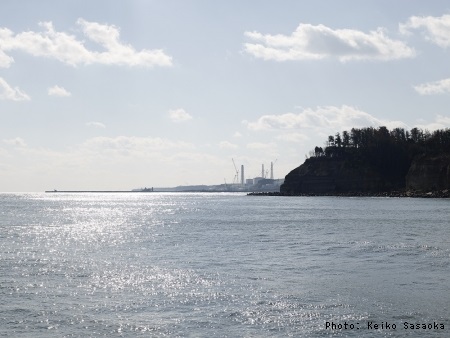
10/25 19:30
Father’s Death and Yonomori (Masataka Matsuda)
Where Things Drift Ashore (Tomoyuki Takahashi)
Man Without Coordinates (Mitsuru Aida)
The man who wants to put up an advertisement (Keisuke Kamiya)
10/26 19:30
The Grass Carp and the Turtle (Takashi Shima)
Home on the Range (Natsuka Kusano)
The Miren Waterfall (Mitsuru Aida)
Ammonite Center (Keisuke Kamiya)
10/27 18:00
Art School (Keisuke Kamiya)
Fukushima Seashore (Ippei Miyake)
Citizens of Koriyama (Saki Yamada)
A Typical Sunday (Natsuka Kusano)
10/28 14:00
About to Snow (Takashi Shima)
The Month Without Water (June) (Ippei Miyake)
From the Periphery of Standard Time (Tomoyuki Takahashi)
At Iwaki General Library (Masataka Matsuda)

Father’s Death and Yonomori
→Script (PDF)Isao Utsugi is in the waiting room of a general hospital in Iwaki. Receiving news that her father-in-law is critically ill, Yuko Hoshio has come up from Tokyo. The oldest son and his wife had been at the hospital all the previous night, but then Yuko took their place to stay with her husband’s father. The next morning, his condition rapidly worsens and he passes away. Yuko is ultimately the only person to witness her father-in-law’s death. In the same waiting room, Utsugi has come to the hospital to secure a seat for the president of the nuclear power industry company he works for, but is unable to do this after he gives up his seat to relatives of the Hoshio family. He is reproached by his superior. Taking a day off work the next day, Utsugi looks for a female high school student in Iwaki and starts talking to one he finds in a train station in Tomioka. This leads him to become a serial killer. (Masataka Matsuda)
Where Things Drift Ashore
→Script (PDF)The carcass of a large marine creature has washed ashore. Workers are measuring the size of this creature now lying on its side. In the same place, a workshop is taking place where participants are creating stories based on the things that drift ashore along the coast. However, the workers seem unaware of the workshop participants, nor do the latter notice the dead marine creature or the workers. It eventually becomes clear that the workers and workshop participants are at the same location but exist in different periods of time, though they then start somehow to perceive each other’s presence despite being separated by time. (Tomoyuki Takahashi)
Man Without Coordinates
→Script (PDF)Oliver from California really prizes his basketball. At Robert’s house, he watches a video about a motorbike that drifted across the Pacific Ocean from Japan due to the 2011 earthquake. On the way home and having lost sight of his ball, Oliver meets the man who was in the video. The man says he is someone who can exist anywhere and at any time, and leaves after telling Oliver to growth up healthily. At the exact same time, he is in Iwaki City watching a gathering of friends who know each other through music. Onishi loses his lighter but the man without coordinates knows where it is. He lovingly watches over these people who live their lives knowing nothing. (Mitsuru Aida)
The man who wants to put up an advertisement
→Script (PDF)I rented a car and was driving when I happened to notice advertising boards along the side of the road. They featured adverts for local hospitals, shops, museums, and so on. Sometimes there would be empty ones with a message saying they were available for potential advertisers. The play was inspired by my curiosity about how much it would cost to put up such an advertisement. The result is a story about two men who cannot see each other. (Keisuke Kamiya)
The Grass Carp and the Turtle
→Script (PDF)In this play, several lines of sight or viewpoints intersect: that of sightseers looking at Tsuruga Castle from the hill of Iimoriyama; the reverse one of looking at Iimoriyama from Tsuruga Castle; that of looking at people and the landscape; that of the Byakkotai teenage samurai warriors viewing Tsuruga Castle from Iimoriyama in the past, a perspective we must not forget in this context; and finally, that of the audience. To act or perform a role is, in a manner of speaking, the action of “borrowing a perspective.” After switching between these perspectives, the gaze of the characters suddenly settles on the grass carp and turtle that live underneath the castle bridge. They exist apparently only to be looked at. Is it possible, then, to borrow their perspectives? And what are they looking at? (Takashi Shima)
Home on the Range
→Script (PDF)Haruka returned from Tokyo to her hometown of Iwaki when her mother died. Several years after the 2011 disaster, she now lives with her young sister, Mahiru, who has a disability, in a public housing complex. Just as she is finally about to finish sorting out the effects of her mother, a habitual hoarder, Haruka receives separate visits from her friend and ex-husband from Tokyo. The story deals with what we choose to keep and discard from our family and memories. Though I spent two years working on the play, I felt disappointed by my inability to portray things like I wanted. (Natsuka Kusano)
The Miren Waterfall
→Script (PDF)A young mountaineer recently died on a snowy peak. Unable to forget the man whom she once slept with, Aoike has become a model specializing in mountaineering fashion shoots. At Sedogaro Gorge on a shoot, she lets slip about that anecdote to Mizumori and is then unable to stop talking. In an attempt to calm the increasingly excited Aoike, Mizumori starts telling a long story about the death of his friend and his knowledge of fatal mountaineering accidents. Unconvinced by this, Aoike begins going back down the mountain alone and is stopped by two men at the base of the mountain. They too both have friends who have died and Aoike cries a little. (Mitsuru Aida)
Ammonite Center
→Script (PDF)This is the story about family. A married couple and an imminent new member of their family go to collect the remains of the deceased. I had a similar experience, whereby I went to my father’s family home to collect the bones of my grandfather. I was curious about what it means to take good care of the bones of someone who has passed away. After all, one cannot remember what the person was like when he or she was alive by looking at their bones. Nonetheless, perhaps we need to have some sort of object that houses our memories and feelings about the departed. Might this be kind of like a fossil? The play was written while I pondered whether we would become fossils millennia from now. (Keisuke Kamiya)
Art School
→Script (PDF)This play is about the students attending an art school run by a husband and wife. The school teaches students the basics of drawing for passing art college entrance exams. Still life drawing is not only the depiction of a motif as it is but also the observation and depiction of the relationship between motifs placed in the same space. This play deals with the sense of distance that exists between people. It is about a very small incident that occurs when someone mistakes that distance. (Keisuke Kamiya)
Fukushima Seashore
→Script (PDF)are three female high school students who are always having fun together. However, one day in a dark warehouse when she is alone with Kinuyo, Kumiko tells her that she likes her more than just as a friend. Time passes and Kumiko is now a mother with a son, Takashi, who is in high school. Takashi is playing with his friends in the snow in a plaza outside a theatre, where the students have just watched a play on an extracurricular outing. They have the opportunity to talk to the actresses who appeared in the play and get excited. Time passes again and it is now Takashi’s wedding. Takashi gets married and has a child. His friend Yoshitake, with whom he was playing that day in the snow, is suffering the aftereffects of an injury on his brain and is unable to speak. Time passes yet again and we arrive at the present day, when it is understood that Takashi, his wife, and Kumiko have died in the tsunami. The scene changes to the seashore, where Kinuyo and Sanae are having a picnic and thinking about Kumiko. Eventually, they start to walk toward the sea. Standing at the edge of the water, they throw flowers into the sea and offer up a prayer. When I first visited Fukushima after the 2011 disaster, I too went to the sea and found myself naturally joining my hands in prayer. This play was written while remembering that moment. (Ippei Miyake)
Citizens of Koriyama
→Script (PDF)This play deals with the Koriyama economic zone, where the people go about their essentially ordinary daily lives while minute misconceptions arise between them. Not understanding this until I actually went to the city, I wrote the play while pulled between these two aspects. (Saki Yamada)
A Typical Sunday
→Script (PDF)Having a certain amount of time to kill, I made a chance visit to Iwaki Marine Tower, where there is a large park. The resulting play emerged from the simple feeling that it would be nice to move around the park on a Segway. It was unfortunately cloudy throughout my trip to Iwaki. If the weather had been sunny, no doubt the content of the play would also have been different. Iwaki Marine Tower left an impression on me as a place I would like to go back to again and again. (Natsuka Kusano)
About to Snow
→Script (PDF)This is an ensemble drama set inside a plane traveling from Itami Airport to Fukushima Airport. The plane is finally airborne, after departing late due to snow on the runway at Fukushima. However, when an announcement is made that the plane may have to turn back to Itami due to the snow, the passengers start complaining loudly. As this unfolds, one female passenger is gripped by a sense of déjà vu, feeling that she has previously experienced this all before. The cabin shakes due to turbulence. The tremors that affect the passengers held together in the confined space that is an airplane, somewhere that does not belong to a particular location, are the forgotten tremors of the disaster, and seem to foresee a possible future. (Takashi Shima)
The Month Without Water (June)
→Script (PDF)This is a play about politics in a certain town. A civic activist father opposed to the construction of a dam once saw a family of foxes with his son, Katsutoshi. Now an adult, Katsutoshi marries the daughter of the mayor, who is an advocate of the dam construction project, and takes his father-in-law’s name. Now aspiring to be a conservative politician, Katsutoshi is concealing something bad about his past. The mayor’s secretary, Ogasawara, whose future role has been usurped by Katsutoshi, tries to leak that secret to a newspaper reporter. The play is an ironic treatment of present-day Japanese politics and how local governments deal with the issue of nuclear power. (Ippei Miyake)
From the Periphery of Standard Time
→Script (PDF)Radio waves transmit the standard time code all over Japan from a giant metal tower rising into the skies from the peak of a mountain. In the town at the base of the mountain, Eri Tsukamoto wants to open a new gardening store in a disused building. Her husband, Koji, is staying at a hospital that is busy preparing to relocate premises, and does not seem to understand his wife’s efforts. Ever since he was hospitalized, their respective senses of time have diverged and though Eri wants to open the store as soon as she can, Koji thinks it is still too early. Their disagreement eventually involves other matters and seems to forebode their separation. But as the old building is turned into the newly opened shop and the hospital is abandoned, the seemingly imminent breakup is avoided. (Tomoyuki Takahashi)
At Iwaki General Library
→Script (PDF)This play is a loose staging of what takes place one day at Iwaki General Library. Locals come and go through the entrance. People browse the shelves. Others read magazines. People relax on the terrace. The librarians deal with requests at the counter. A range of people spends time casually and variously in the space that is the library. (Masataka Matsuda)
Links
F/T16
https://www.festival-tokyo.jp/16/en/program/performing_fukushima/
F/T17
https://www.festival-tokyo.jp/17/en/program/performing_fukushima_17/
F/T18
External Links
marebito theater company
http://www.marebito.org/
The Japan Times (October 7, 2016)
Festival/Tokyo speaks with a defiant voice
https://www.japantimes.co.jp/culture/2016/10/06/stage/festivaltokyo-speaks-defiant-voice/
